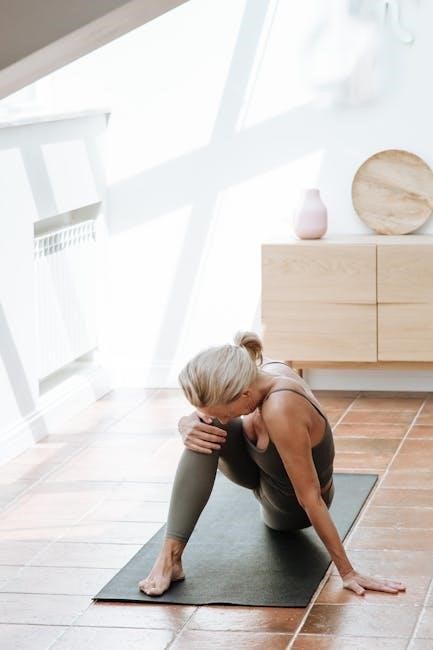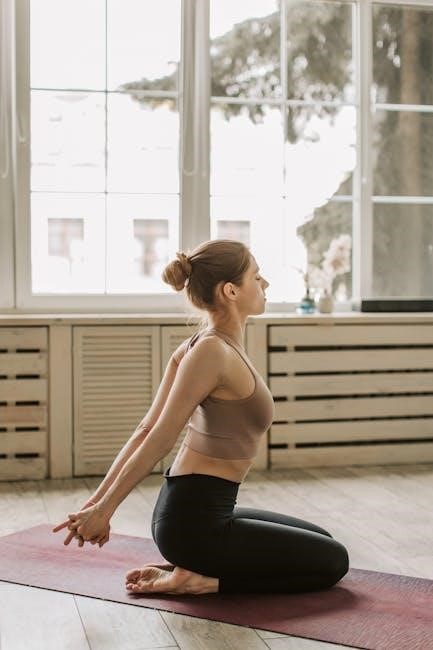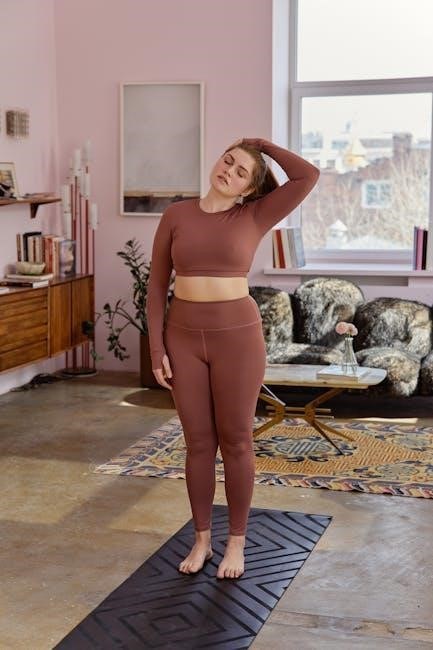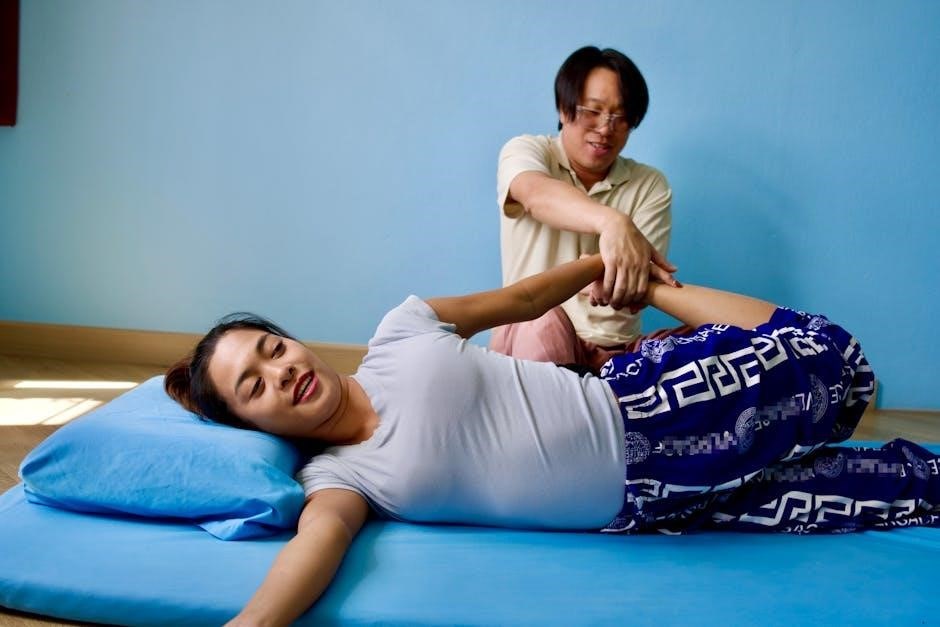Full Body Stretching Routine PDF: A Comprehensive Guide
Discover a detailed guide to enhance flexibility and well-being! This resource offers dynamic and static stretches‚ ideal for daily routines‚ recovery‚ or pre-workout preparation.
Full body stretching is a vital component of overall health and fitness‚ often underestimated in its importance. It’s not exclusive to athletes; everyone can benefit from incorporating regular stretching into their daily life‚ regardless of their activity level. This practice involves systematically elongating all major muscle groups‚ improving flexibility‚ range of motion‚ and posture.
A comprehensive routine targets the neck‚ shoulders‚ chest‚ back‚ hips‚ legs‚ and ankles. Whether you’re seeking to enhance athletic performance‚ recover from intense workouts‚ or simply improve your daily comfort‚ a well-structured stretching program is invaluable. This guide provides the tools and knowledge to create a personalized routine‚ promoting a healthier‚ more mobile you.
Benefits of a Regular Stretching Routine
Consistent full body stretching yields significant benefits beyond increased flexibility. It improves posture‚ reducing strain and discomfort‚ and enhances athletic performance by allowing a greater range of motion. Stretching boosts blood circulation‚ delivering essential nutrients to muscles and reducing muscle soreness post-exercise.
Furthermore‚ regular stretching can alleviate stress and tension‚ promoting relaxation and mental clarity. It can also contribute to injury prevention by preparing muscles for activity and improving joint health. Incorporating stretching into your routine isn’t just about physical fitness; it’s an investment in your overall well-being‚ enhancing both body and mind.
When to Stretch: Optimal Timing
Determining the ideal time to stretch depends on the type of stretch. Dynamic stretches are most effective as part of a warm-up‚ preparing muscles for activity by increasing blood flow and range of motion. Perform these before workouts or physical exertion.
Static stretches‚ holding a stretch for a period of time‚ are best suited for cool-downs‚ helping muscles recover and reduce soreness after exercise. However‚ stretching can also be beneficial on rest days to maintain flexibility and improve overall mobility. Consider a short routine daily‚ or at least two to three times per week‚ for optimal results.
Dynamic vs. Static Stretching: Understanding the Difference
Dynamic stretching involves controlled movements that take muscles through their full range of motion. Examples include arm circles‚ leg swings‚ and torso twists – preparing the body for activity. It enhances mobility and increases blood flow‚ making it ideal for warm-ups.
Static stretching‚ conversely‚ focuses on holding a stretch in a challenging but comfortable position for a period of time. This improves flexibility and aids in recovery. Static stretches are best performed after exercise‚ during cool-downs‚ or on rest days. Understanding this difference is crucial for a safe and effective stretching routine.

Warm-Up: Dynamic Stretches (5-10 Minutes)

Prepare your body with fluid movements! Engage in arm circles‚ leg swings‚ torso twists‚ cat-cow‚ hip circles‚ and walking lunges to increase mobility.
Arm Circles
Arm circles are a fantastic dynamic stretch to warm up the shoulder joints and surrounding muscles. Begin by standing with your feet shoulder-width apart and your arms extended out to the sides at shoulder height. Ensure your elbows remain relatively straight‚ but not locked.
Start with small circles‚ gradually increasing the size of the circles as you feel comfortable. Perform forward arm circles for approximately 30 seconds‚ focusing on controlled movements. Then‚ reverse the direction and perform backward arm circles for another 30 seconds.
This exercise improves range of motion and prepares the shoulders for more strenuous activity. Pay attention to your posture‚ keeping your core engaged and your back straight. Avoid shrugging your shoulders during the movement. Consistent practice will enhance shoulder flexibility and prevent injuries.
Leg Swings

Leg swings are a dynamic stretch that effectively warms up the hip flexors‚ hamstrings‚ and glutes. Begin by standing tall‚ holding onto a wall or stable object for balance if needed. Keep your core engaged and your back straight throughout the exercise.
Gently swing one leg forward and backward in a controlled motion‚ maintaining a slight bend in the knee. Avoid forcing the swing; focus on a comfortable range of motion. Perform 10-15 swings per leg. Then‚ switch to side-to-side leg swings‚ swinging your leg across your body and back.
This movement improves hip mobility and prepares the legs for activity. Proper form is crucial to prevent injury. Avoid arching your back or twisting your torso. Leg swings are a simple yet effective way to increase flexibility and enhance performance.
Torso Twists
Torso twists are a fantastic dynamic stretch to improve spinal mobility and warm up the core muscles. Stand with your feet shoulder-width apart‚ knees slightly bent‚ and arms bent at the elbows‚ held out in front of you. Keep your back straight and core engaged throughout the movement.
Gently twist your torso from side to side‚ rotating your upper body while keeping your hips relatively stable. Allow your arms to swing naturally with the twist‚ but avoid forcing the rotation. Aim for 10-15 twists on each side.
This stretch enhances flexibility in the spine and obliques. Controlled movements are key; avoid jerky motions. Focus on feeling a gentle stretch in your back and sides; Torso twists prepare the core for more intense activity and improve overall posture.
Cat-Cow Stretch
Cat-Cow stretch is a gentle‚ flowing movement that improves spinal flexibility and coordination. Begin on your hands and knees‚ ensuring your hands are shoulder-width apart and knees are hip-width apart. Maintain a neutral spine with your head in a relaxed position.
Inhale as you drop your belly towards the floor‚ arching your back and lifting your head and tailbone towards the ceiling – this is Cow pose. Exhale as you round your spine towards the ceiling‚ tucking your chin to your chest and drawing your belly button towards your spine – this is Cat pose.
Continue alternating between Cat and Cow for 10-15 repetitions‚ synchronizing your breath with each movement. This stretch gently massages the spine and abdominal organs‚ relieving stress and promoting relaxation. It’s a wonderful way to increase spinal mobility.
Hip Circles
Hip circles are a fantastic dynamic stretch to improve mobility in the hip joint and lower back. Stand with your feet shoulder-width apart‚ hands gently placed on your hips. Maintain a slight bend in your knees throughout the exercise to protect your joints.
Begin by making large‚ controlled circles with your hips‚ as if you’re drawing a circle with your hip bones. Move in one direction for 10-15 repetitions‚ focusing on a smooth‚ fluid motion. Then‚ reverse the direction and repeat for another 10-15 repetitions.
Engage your core muscles to stabilize your spine and prevent excessive movement in your lower back. This stretch helps to loosen tight hip flexors and improve range of motion‚ preparing your body for more intense activity.
Walking Lunges with a Twist
Walking lunges with a twist combine lower body strength with spinal mobility‚ offering a comprehensive dynamic stretch. Begin by stepping forward into a lunge position‚ ensuring your front knee is aligned over your ankle and your back knee lowers towards the ground.
As you’re in the lunge‚ gently twist your torso towards the side of your front leg‚ keeping your core engaged and your back straight. Hold the twist briefly‚ then return to center and push off with your front foot to step forward into the next lunge.
Repeat this movement‚ alternating legs and twisting towards the side of each front leg for 10-12 repetitions per side. This stretch targets the hip flexors‚ glutes‚ and obliques‚ improving flexibility and coordination.

Cool-Down: Static Stretches (10-15 Minutes)
Transition into static stretches post-workout to enhance flexibility and promote recovery. Hold each stretch for 30 seconds‚ focusing on major muscle groups.
Neck Stretches (Side & Forward)
Begin with gentle neck stretches to release tension and improve range of motion. For side neck stretches‚ slowly tilt your head towards your shoulder‚ feeling a stretch along the opposite side of your neck. Hold for 15-30 seconds and repeat on the other side.
To perform forward neck stretches‚ gently drop your chin towards your chest‚ feeling a stretch in the back of your neck. Avoid forcing the stretch; it should be comfortable. Maintain a relaxed posture throughout.
Remember to breathe deeply during each stretch. Avoid any jerky movements or overextension. These stretches are excellent for relieving stress and improving posture. Focus on controlled movements and listen to your body‚ stopping if you feel any pain. Regular neck stretches can help prevent stiffness and discomfort.

Shoulder Stretches (Cross-Body & Overhead)
Improve shoulder flexibility with these targeted stretches. For a cross-body shoulder stretch‚ bring one arm across your body and gently pull it closer with your other hand‚ feeling the stretch in your shoulder. Hold for 20-30 seconds and repeat on the opposite side.
The overhead shoulder stretch involves reaching one arm overhead and bending it at the elbow‚ then gently pulling your elbow towards your head with your other hand. Focus on feeling the stretch in your triceps and shoulder.
Ensure your movements are slow and controlled. Breathe deeply throughout each stretch to enhance relaxation. Avoid pushing yourself beyond your comfortable range of motion. Consistent shoulder stretching can alleviate tension and improve posture. These stretches are beneficial for anyone spending long hours at a desk or engaging in repetitive arm movements.
Chest Stretch (Doorway Stretch)
Open up your chest and counteract the effects of slouching with this simple yet effective stretch. Stand in a doorway and place your forearms on the doorframe‚ elbows bent at 90 degrees. Gently lean forward‚ feeling a stretch across your chest and the front of your shoulders.
Maintain a straight back and avoid arching your lower back. Breathe deeply and hold the stretch for 20-30 seconds. You can adjust the height of your arms on the doorframe to target different areas of your chest.
Regularly performing this stretch can improve posture‚ increase lung capacity‚ and alleviate upper back pain. It’s particularly beneficial for individuals who spend extended periods sitting or working at a computer. Remember to listen to your body and stop if you feel any sharp pain.
Triceps Stretch
Target those often-tight triceps muscles with this straightforward stretch. Raise one arm overhead and bend it at the elbow‚ bringing your hand towards the middle of your upper back; Use your other hand to gently pull your elbow further down‚ deepening the stretch.
Keep your upper arm close to your head throughout the movement. Feel the stretch along the back of your upper arm – the triceps muscle. Hold this position for 20-30 seconds‚ breathing deeply and consistently.
This stretch is excellent for improving arm flexibility and range of motion‚ particularly beneficial for athletes or those involved in activities requiring overhead movements. Ensure you don’t force the stretch; a gentle pull is sufficient. Repeat on the other side for balanced muscle development.
Back Stretches (Child’s Pose & Spinal Twist)
Relieve tension in your back with two effective stretches: Child’s Pose and Spinal Twist. Begin with Child’s Pose – kneel on the floor‚ sit back on your heels‚ and fold forward‚ extending your arms in front of you. Rest your forehead on the ground and breathe deeply‚ feeling a gentle stretch in your lower back. Hold for 30 seconds.
Next‚ transition to a Spinal Twist. Lie on your back with knees bent and feet flat. Keep your shoulders flat on the floor and gently drop both knees to one side‚ feeling a stretch along your spine. Hold for 20-30 seconds‚ then repeat on the other side.
These stretches improve spinal mobility and reduce back pain. Remember to move slowly and avoid forcing the twist. Focus on deep‚ controlled breathing throughout both exercises.
Hamstring Stretch (Seated & Standing)
Target tight hamstrings with both seated and standing stretches for optimal flexibility. Start with the seated hamstring stretch: sit on the floor with legs extended straight. Reach towards your toes‚ keeping your back as straight as possible. Hold for 20-30 seconds‚ feeling the stretch in the back of your legs.
For the standing hamstring stretch‚ place one leg straight out in front of you‚ heel on the ground‚ and toes pointed up. Gently lean forward from the hips‚ keeping your back straight‚ until you feel a stretch. Hold for 20-30 seconds and repeat on the other leg.
Consistent hamstring stretching improves flexibility‚ reduces injury risk‚ and enhances athletic performance. Avoid bouncing and focus on a controlled‚ sustained stretch. Breathe deeply throughout each exercise.
Quadriceps Stretch
Effectively stretch your quadriceps – the muscles at the front of your thighs – to improve flexibility and range of motion. Begin by standing tall and bending one knee‚ bringing your heel towards your glutes. Reach back with the same-side hand to grasp your foot or ankle.
Gently pull your heel closer to your glutes‚ feeling a stretch in the front of your thigh. Maintain an upright posture and avoid arching your back. Hold the stretch for 20-30 seconds‚ then repeat on the other leg. For balance‚ you can hold onto a wall or chair.
Regular quadriceps stretching can alleviate muscle tightness‚ improve athletic performance‚ and prevent injuries. Remember to breathe deeply and avoid bouncing during the stretch. Focus on a controlled‚ sustained stretch for best results.
Hip Flexor Stretch
Target your hip flexors – crucial for mobility and posture – with this effective stretch. Begin in a kneeling position‚ with one knee on the ground and the other foot flat on the floor in front of you‚ forming a 90-degree angle.

Gently push your hips forward‚ maintaining a straight back and engaging your core. You should feel a stretch in the front of the hip of the leg that’s kneeling. To deepen the stretch‚ raise the arm on the same side as the kneeling leg overhead.
Hold this position for 20-30 seconds‚ breathing deeply. Repeat on the other side. Tight hip flexors can contribute to lower back pain‚ so consistent stretching is beneficial. Ensure a controlled movement and avoid overextending.
Calf Stretch (Gastrocnemius & Soleus)
Improve ankle flexibility and prevent lower leg tightness with dedicated calf stretches. Start by standing facing a wall‚ placing your hands on it for support. Extend one leg back‚ keeping the heel firmly planted on the ground. Lean forward‚ bending your front knee‚ until you feel a stretch in your calf.
This targets the gastrocnemius. To stretch the soleus‚ slightly bend the back knee while keeping the heel down. Hold each stretch for 20-30 seconds‚ feeling a comfortable pull.
Tight calves can impact posture and contribute to foot pain. Regular stretching enhances range of motion and supports athletic performance. Remember to breathe deeply throughout the exercise and avoid bouncing.

Ankle Rotations
Enhance ankle mobility and prepare your joints for activity with simple ankle rotations. Begin by sitting or standing with your feet flat on the floor. Lift one foot slightly off the ground.
Slowly rotate your ankle clockwise for 10-15 repetitions‚ focusing on a full range of motion. Then‚ reverse the direction and rotate counter-clockwise for the same number of repetitions. Repeat this process with the other ankle.
Ankle rotations improve circulation‚ reduce stiffness‚ and can help prevent injuries. This exercise is particularly beneficial before and after workouts‚ or after prolonged periods of sitting. Focus on controlled movements and avoid forcing the rotation.

Creating Your Own Full Body Stretching PDF
Personalize your flexibility journey by compiling stretches! Adjust frequency‚ duration‚ and modifications to suit your fitness level‚ ensuring safe and effective routines.
Frequency and Duration of Stretching
Establishing a consistent stretching routine is key to realizing its benefits. For optimal results‚ healthy adults should aim for flexibility exercises – encompassing stretches‚ yoga‚ or Tai Chi – at least two to three times per week‚ targeting all major muscle groups.
However‚ daily stretching can be even more advantageous‚ particularly for those seeking to improve mobility or recover from intense physical activity. A full body routine doesn’t necessarily require lengthy sessions; even 10-15 minutes can be profoundly effective.
Consider incorporating shorter stretching sessions throughout the day‚ or dedicating a longer block of time a few times weekly. Listen to your body and adjust the duration based on your individual needs and recovery rate. Consistency‚ rather than intensity‚ is paramount for long-term flexibility gains.
Hold Times for Static Stretches

When performing static stretches – holding a stretch in a challenging but comfortable position – proper hold times are crucial for maximizing benefits and minimizing risk of injury. Generally‚ holding each stretch for 15 to 30 seconds is recommended. This duration allows the muscles to relax and lengthen‚ improving flexibility over time.
For deeper stretches or areas of particular tightness‚ you might consider holding for up to 60 seconds. However‚ avoid pushing beyond your comfort zone. Remember to breathe deeply and consistently throughout each stretch‚ promoting relaxation and enhancing the stretch’s effectiveness.
Repeat each static stretch 2-3 times to further improve flexibility. Avoid bouncing or jerking movements‚ as these can cause muscle strains. Prioritize quality over quantity‚ focusing on maintaining proper form and a controlled‚ sustained stretch.
Modifications for Different Fitness Levels
Adapting a full body stretching routine to your individual fitness level is essential for safety and effectiveness. Beginners should focus on gentler stretches‚ reducing the range of motion and holding times. Utilize props like straps or towels to assist with reaching‚ if needed.
Intermediate individuals can gradually increase the intensity and duration of stretches‚ exploring deeper ranges of motion. Advanced practitioners may incorporate more challenging variations‚ such as active isolated stretching or partner stretching‚ always with careful attention to form.
Listen to your body and never force a stretch. Modifications might include performing stretches seated instead of standing‚ or reducing the depth of a lunge. Remember‚ consistency is key‚ regardless of your fitness level. Prioritize proper technique over achieving extreme flexibility.
Important Considerations & Safety Tips
Prioritize safety during your full body stretching routine. Always warm up muscles beforehand with dynamic stretches to increase blood flow and prepare tissues; Never bounce while stretching; focus on slow‚ controlled movements to avoid injury.
Breathe deeply and consistently throughout each stretch‚ promoting relaxation and improving flexibility. Avoid stretching to the point of pain; a gentle pull is sufficient. Listen to your body and stop if you experience any discomfort.
Consult a healthcare professional before starting any new exercise program‚ especially if you have pre-existing conditions. Stay hydrated and maintain proper posture during stretches. Consistency is vital‚ but rest days are equally important for muscle recovery and preventing overextension.
Resources for Printable Stretching Routines
Explore a wealth of online resources for printable full body stretching routines! Fitness buff Alex Crockford offers a valuable 10-minute routine‚ easily accessible for home workouts. Numerous websites provide downloadable PDFs catering to various fitness levels and needs.
Discover routines designed for active recovery‚ post-workout cool-downs‚ or pre-exercise preparation. Many resources detail specific programs for runners‚ athletes‚ and those seeking improved hip flexibility. Look for guides outlining optimal stretching frequency‚ duration‚ and hold times.
Websites dedicated to health and wellness frequently feature comprehensive stretching programs; Consider utilizing resources that emphasize both dynamic and static stretches for a well-rounded approach. Remember to choose routines aligned with your individual goals and physical capabilities.
